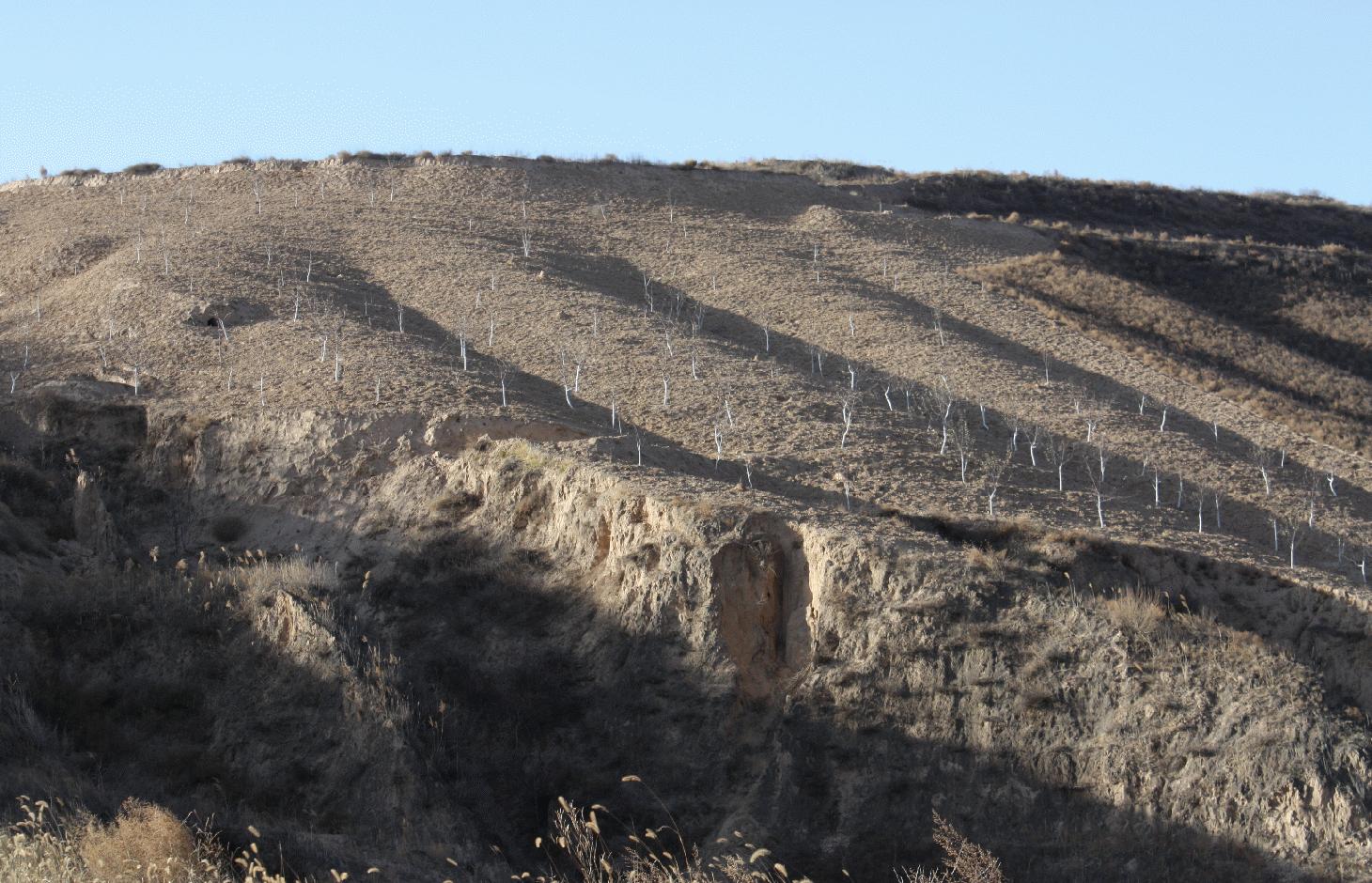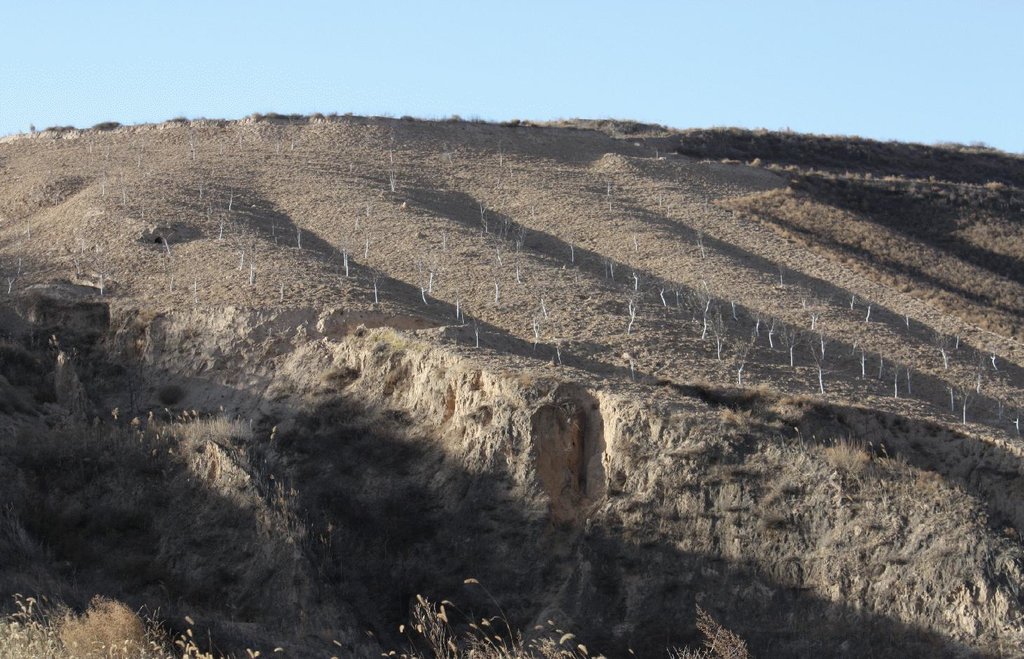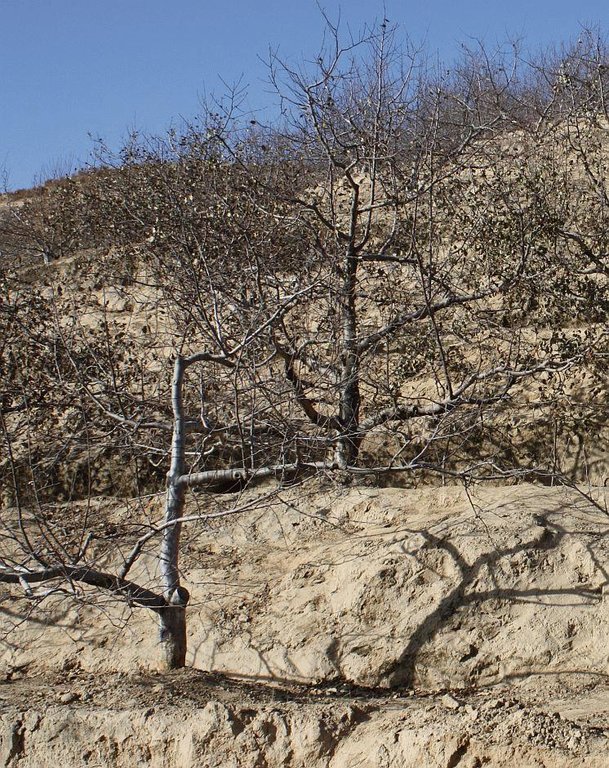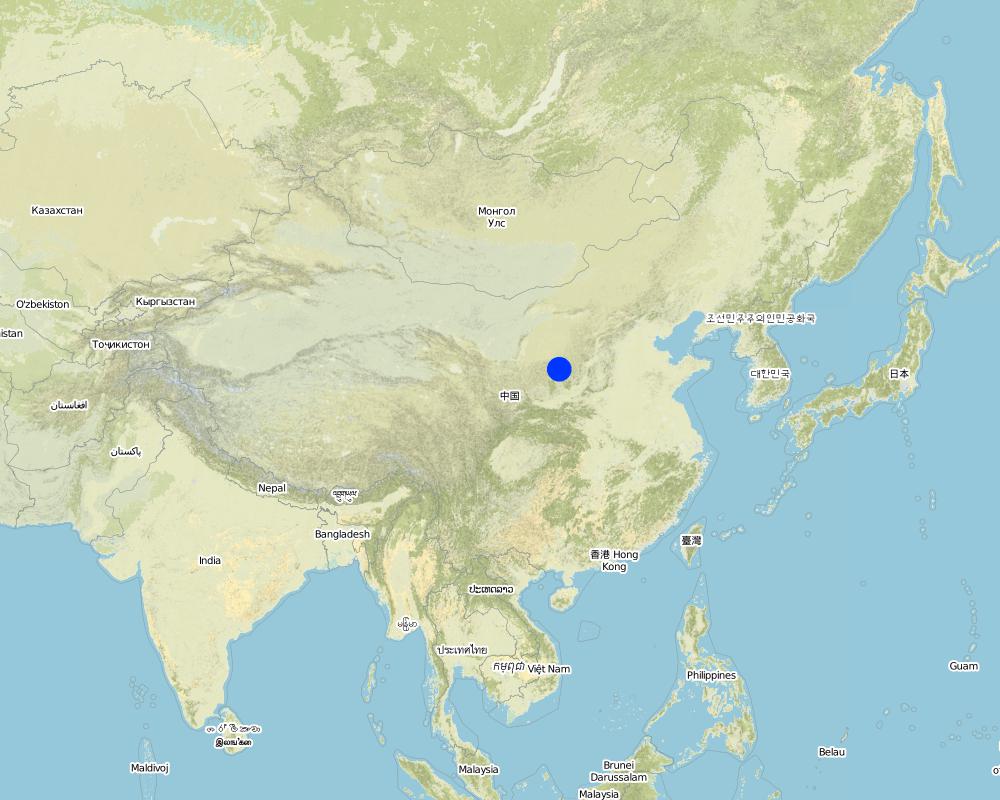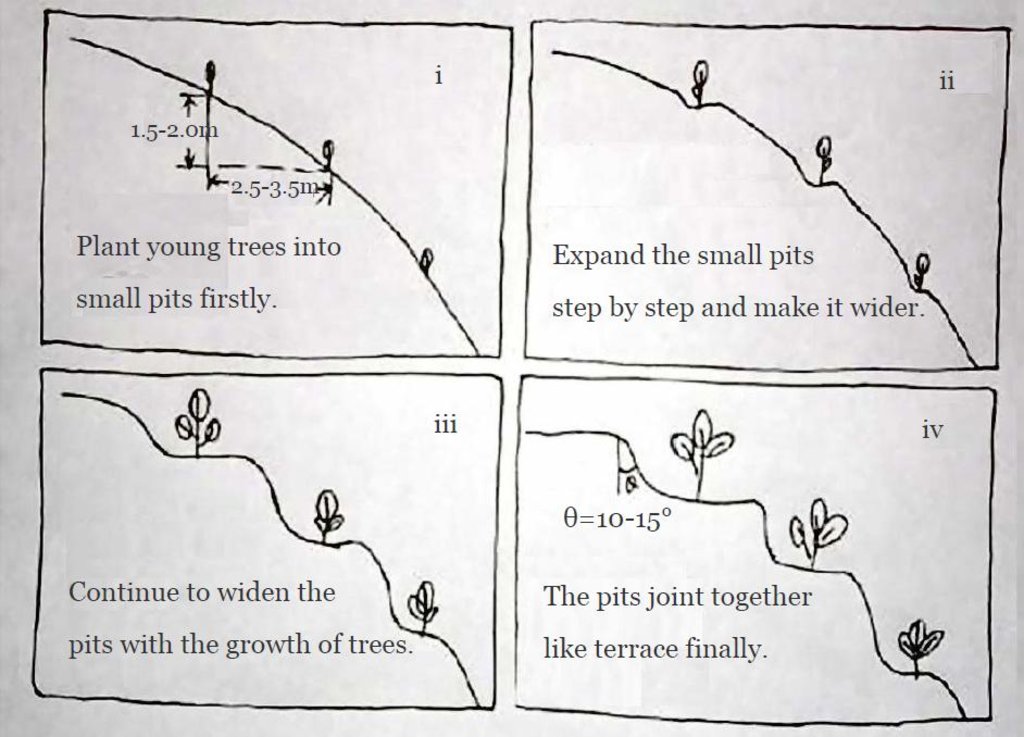Progressive bench terrace [الصين]
- تاريخ الإنشاء:
- تحديث:
- جامع المعلومات: Fei WANG
- المحرر: –
- المراجعون: Deborah Niggli, Alexandra Gavilano
树盘,逐年扩盘
technologies_1522 - الصين
عرض الأقسام
توسيع الكل طي الكل1. معلومات عامة
1.2 تفاصيل الاتصال بالأشخاص الرئيسيين لمصدر المعلومات والمؤسسات المشاركة في تقييم وتوثيق التقنية
متخصص في الإدارة المستدامة للأراضي:
Chen Yunming
Institute of Soil and Water Conservation, CAS and MWR
الصين
متخصص في الإدارة المستدامة للأراضي:
Liu Guobin
Institute of Soil and Water Conservation, CAS and MWR
الصين
متخصص في الإدارة المستدامة للأراضي:
Cao Qingyu
الصين
اسم المشروع الذي سهّل توثيق/تقييم التقنية (إذا كان ذلك على صلة)
DESIRE (EU-DES!RE)اسم المؤسسة (المؤسسات) التي سهلت توثيق/تقييم التقنية (إذا كان ذلك على صلة)
Northwest A&F University (NWAFU) - الصين1.3 الشروط المتعلقة باستخدام البيانات الموثقة من خلال WOCAT
يوافق جامع المعلومات والشخص (لاشخاص) الرئيسي لمصدر المعلومات على الشروط المتعلقة باستخدام البيانات الموثقة من خلال WOCAT:
نعم
2. وصف تقنيةالإدارة المستدامي للأراضي
2.1 وصف مختصر للتقنية
تعريف التقنية:
Bench terraces are progressively expanded to form a fully developed terrace system in order to reduce runoff and soil erosion on medium- to high- angled loess slopes.
2.2 وصف تفصيلي للتقنية
الوصف:
n Miaowan Village, the technology is mainly applied to apple tree plantations. Tree seedlings are planted in rows every 4 m along the contour with a spacing of 2.5-3.5 m between rows. Trees are planted in pits 40 cm diameter and 3040 cm deep. Manure and/or fertilizer are applied and the seedlings are watered.
Around each tree, soil from the upper parts of the slope is removed and deposited below in order to extend the flat terrain. Over 5-10 years, the terraces become enlarged around each tree and form a terrace with the neighbouring trees along the contour, such that the slopes are transformed into level bench terraces. The fruit trees are located in the middle of the terrace. All the work is done manually using shovels.
Purpose of the Technology: The main purpose of this technology is to reduce runoff and soil erosion on the slope and to improve soil quality and soil moisture retention. It is a sustainable land use technology for small farmers because farmers can use their spare time to improve the land’s condition during the growth of the trees.
A major aim is to conserve water and reduce runoff. Soil erosion in this village is very severe and the soil erosion rate before amounted to 60-100 tonnes per hectare per year and was reduced practically to zero as a result of building the terraces. Slope gradients are very steep (around 20-35 degrees). The main income of local farmers is from orchards.
Establishment / maintenance activities and inputs: The establishment phase thus takes 5-10 years. Afterwards maintenance inputs are restricted to repairing the terrace walls.
2.3 صور التقنية
2.5 البلد/المنطقة/المواقع التي تم تنفيذ التقنية فيها والتي يغطيها هذا التقييم
البلد:
الصين
المنطقة/الولاية/المحافظة:
Shaanxi
مزيد من التفاصيل حول الموقع:
Miaowan Village, Xuejiagou Watershed
حدد انتشار التقنية:
- منتشرة بالتساوي على مساحة
إذا كانت التقنيةا موزعة بالتساوي على منطقة ما، حدد المساحة المغطاة (بالكيلومتر المربع):
2,55
التعليقات:
Boundary points of the Technology area: The technology is around the village.
Total area covered by the SLM Technology is 2.55 km2.
The whole area of this watershed is about 7.5 Km^2. There are a lot of orchard, mostly apple, in this watershed. It is one of typical watershed with specially soil erosion problem despite the high plant coverage.
Map
×2.6 تاريخ التنفيذ
في حالة عدم معرفة السنة بالتحديد، يرجى الإشارة إلى التاريخ التقريبي:
- منذ 10-50 سنة
2.7 إدخال التقنية
حدد كيف تم إدخال التقنية:
- من خلال ابتكار مستخدمي الأراضي
التعليقات (نوع المشروع، الخ):
It is a kind of traditional method.
3. تصنيف تقنية الإدارة المستدامي للأراضي
3.1 الغرض الرئيسي ( الأغراض الرئيسية) للتقنية
- الحد من تدهور الأراضي ومنعه وعكسه
3.2 نوع (أنواع) استخدام الأراضي الحالية حيث يتم تطبيق التقنية
استخدامات الأراضي مختلطة ضمن نفس وحدة الأرض:
نعم
حدد استخدام الأراضي المختلطة (المحاصيل / الرعي / الأشجار):
- الحراجة الزراعية

الأراضي الزراعية
- زراعة سنوية
- زراعة الأشجار والشجيرات
الزراعة السنوية - حدد المحاصيل:
- المحاصيل الجذرية/الدرنية - البطاطس
زراعة الأشجار والشجيرات -حدد المحاصيل:
- الثمار التفاحية (التفاح، الكمثرى، السفرجل، الخ)
حدد:
Longest growing period in days: 300Longest growing period from month to month: Mar - NovSecond longest growing period in days: 200Second longest growing period from month to month: Apr - Oct
التعليقات:
Major land use problems (compiler’s opinion): On moderate- to high-angled slopes, water loss and soil erosion are very high. Outside the protected canopy of the trees rainsplash impact during heavy storms is very severe. The local farmers clear all the wild grasses and shrubs, such as Korshinsk Peashrub, Artemisia scoparia, Leymus secalinus, Stipa bungeana, Lespedeza davurica etc. to reduce competition with the fruit trees. Consequently, the soil is bare and unprotected
3.4 إمدادات المياه
إمدادات المياه للأرض التي يتم تنفيذ التقنية عليها:
- بعلية
3.5 مجموعةالإدارة المستدامة للأراضي التي تنتمي إليها هذه التقنية
- التدابير المتقاطعة للمنحدرات
3.6 التدابير التقنية في مجال إلادارة المستدامة للأراضي

التدابير البنيوية
- S11: غير ذلك
التعليقات:
Main measures: structural measures
3.7 الأنواع الرئيسية من تدهور الأراضي التي تناولتها التقنية

تآكل التربة بالمياه
- الوزن(Wt): فقدان التربة السطحية/تآكل السطح

تدهور المياه
- (Ha): التجفيف
التعليقات:
Main type of degradation addressed: Wt: loss of topsoil / surface erosion
Secondary types of degradation addressed: Ha: aridification
Main causes of degradation: Heavy / extreme rainfall (intensity/amounts) (Storm are strong in summer.), other natural causes (avalanches, volcanic eruptions, mud flows, highly susceptible natural resources, extreme topography, etc.) specify (orchards on steep slopes without conservation measures), poverty / wealth (to increase the yield and income of orchard.)
Secondary causes of degradation: deforestation / removal of natural vegetation (incl. forest fires) (There is no natural grass cover here.), droughts (Lack of water for the cash trees)
3.8 منع أو حد أو عكس تدهور الأراضي
تحديد هدف التقنية فيما يتعلق بتدهور الأراضي:
- منع تدهور الأراضي
- الحد من تدهور الأراضي
التعليقات:
Main goals: prevention of land degradation
Secondary goals: mitigation / reduction of land degradation
4. المواصفات الفنية، وأنشطة التنفيذ، والمدخلات، والتكاليف
4.1 الرسم الفني للتقنية
المواصفات الفنية (المتعلقة بالرسم الفني):
i: first year: planting of fruit trees along the contour in small pits
ii: after 3-4 years: a small terrace is built up around each tree (as the tree grows it needs more water, which is collected from the platform around the trees..
iii: after 5-8 years: terraces develop
iv: final stage: fully developed level bench terraces
Owing to the soil properties of loess, there is no need to separate surface and subsoil as there is little difference between them. Therefore, soil can be moved directly from upper to lower parts of the terrace without changing soil fertility.
Location: Miaowan Village, Xuejiagou Watershed. Ansai County, Shaanxi Province, China
Date: 2008-12-20
Technical knowledge required for land users: moderate (It is easy to understand and implement.)
Main technical functions: control of concentrated runoff: retain / trap, reduced soil loss
Secondary technical functions: reduction of slope angle, increase of infiltration
Reshaping surface
Vertical interval between structures (m): 1
Spacing between structures (m): 2.5
Depth of ditches/pits/dams (m): 1..5
Width of ditches/pits/dams (m): 2.5
Length of ditches/pits/dams (m): 100-150
Construction material (earth): Using the earth of the same land.
Slope (which determines the spacing indicated above): 45%
If the original slope has changed as a result of the Technology, the slope today is: 2%
Lateral gradient along the structure: 2%
المؤلف:
Wang Fei, Yangling, Shaanxi Province, China
4.2 معلومات عامة بخصوص حساب المدخلات والتكاليف
حدد العملة المستخدمة لحساب التكاليف:
- دولار أمريكي USD
اذكر متوسط تكلفة أجر العمالة المستأجرة في اليوم الواحد:
14.2
4.3 أنشطة التأسيس
| النشاط | التوقيت (الموسم) | |
|---|---|---|
| 1. | Plant the young trees with small pits. | Before practice |
| 2. | The soils from the upper parts of the slope is shovelled away and deposited on the lower side of the trees | |
| 3. | Expand the pits into a large platform year by year. | |
| 4. | 3.4 years after planning the trees a level platform of 2 to 3 square meters around the trees is build. | |
| 5. | The platforms increase and the space between trees is change into terrace. |
4.4 التكاليف والمدخلات اللازمة للتأسيس
| تحديد المدخلات | الوحدة | الكمية | التكاليف لكل وحدة | إجمالي التكاليف لكل مدخل | % من التكاليف التي يتحملها مستخدمو الأراضي | |
|---|---|---|---|---|---|---|
| العمالة | Planting trees | Person/day | 120,0 | 7,3 | 876,0 | 100,0 |
| العمالة | Building pits | Person/day | 750,0 | 7,3 | 5475,0 | 100,0 |
| إجمالي تكاليف إنشاء التقنية | 6351,0 | |||||
| إجمالي تكاليف إنشاء التقنية بالدولار الأمريكي | 6351,0 | |||||
التعليقات:
Duration of establishment phase: 60 month(s)
4.5 الصيانة/الأنشطة المتكررة
| النشاط | التوقيت/الوتيرة | |
|---|---|---|
| 1. | Repair the bank of year-after-year terraced land | Annual after it formed |
4.6 التكاليف والمدخلات اللازمة للصيانة/للأنشطة المتكررة (سنويًا)
| تحديد المدخلات | الوحدة | الكمية | التكاليف لكل وحدة | إجمالي التكاليف لكل مدخل | % من التكاليف التي يتحملها مستخدمو الأراضي | |
|---|---|---|---|---|---|---|
| العمالة | Reparing of terraced land | Person/day | 15,0 | 14,6 | 219,0 | 100,0 |
| إجمالي تكاليف صيانة التقنية | 219,0 | |||||
| إجمالي تكاليف صيانة التقنية بالدولار الأمريكي | 219,0 | |||||
التعليقات:
Machinery/ tools: spade and hoe
The costs are calculated assuming a local wage rate of 14.2 US$/day.
4.7 أهم العوامل المؤثرة على التكاليف
قدم وصفا لأهم العوامل التي تؤثر على التكاليف:
Slope is the most important factor. The steeper it is, the higher the cost. Labour was not considered as a cost before, but now it is expensive so that some local farmers do not use this technology.
5. البيئة الطبيعية والبشرية
5.1 المناخ
هطول الأمطار السنوي
- < 250 مم
- 251- 500 ملم
- 501 - 750ملم
- 1,000-751 ملم
- 1,500-1,100 ملم
- 2,000-1,500 ملم
- 3,000-2,001 ملم
- 4,000-3,100 ملم
- > 4000 ملم
المواصفات/التعليقات على هطول الأمطار:
The mean annual rainfall in the basin is 515.2 mm in the duration from 1952 to 2000. The rainfall from May to Oct accounts for 446.8 mm, up to 86.7%; and that from Jun to Sep accounts for 367.6 mm
المنطقة المناخية الزراعية
- شبه قاحلة
Thermal climate class: temperate. The accumulating time that temperature above 0 ℃ about 3800 hours, and that above 10 ℃ is more than 3200 hours
It is based on the classification sysytem only based on the rainfall
5.2 طوبوغرافيا
متوسط الانحدارات:
- مسطح (0-2%)
- بسيط (3-5%)
- معتدل (6-10%)
- متدحرج (11-15%)
- تلال (16-30%)
- شديدة الانحدار(31-60%)
- فائقة الانحدار (>60%)
التضاريس:
- هضاب/سهول
- أثلام مرتفعة
- المنحدرات الجبلية
- منحدرات التلال
- منحدرات في السفوح
- قاع الوادي
المنطقة الارتفاعية:
- 100-0 متر فوق سطح البحر
- 500-101 متر فوق سطح البحر
- 1,000-501 متر فوق سطح البحر
- 1,500-1,001 متر فوق سطح البحر
- 2,000-1,501 متر فوق سطح البحر
- 2,500-2,100 متر فوق سطح البحر
- 3,000-2,501 متر فوق سطح البحر
- 4,000-3,001 متر فوق سطح البحر
- > 4000 متر فوق سطح البحر
وضح ما إذا كانت التقنية مطبقة على وجه التحديد في:
- غير ذات صلة
التعليقات والمواصفات الإضافية بشأن التضاريس:
Altitudinal zone 501-1,000 m a.s.l.: Most area is in this altitudinal zonation
Landforms: Based on 1:100 thousand scale landform map
Slopes on average: Based on 1:100 thousand scale landform map
5.3 التربة
متوسط عمق التربة:
- ضحل جدًا (0-20 سم)
- ضحلة (21-50 سم)
- متوسطة العمق (51-80 سم)
- عميقة (81-120 سم)
- عميقة جدًا (> 120 سم)
قوام التربة (التربة السطحية):
- متوسط ( طميي، سلتي)
المواد العضوية في التربة السطحية:
- منخفضة (<1%)
إذا كان متاحًا، قم بإرفاق وصف كامل للتربة أو تحديد المعلومات المتوفرة، على سبيل المثال نوع التربة، الرقم الهيدروجيني/ درجة حموضة التربة، قدرة التبادل الكاتيوني، النيتروجين، الملوحة وما إلى ذلك.
Soil depth on average: The depth of Loess varies from nearly 30 m to more than 100 m in Yanhe River Basin. The depth of soil is less than this but it could be nearly 10 meters in common
Soil texture (topsoil): Here are more than 50% soil particle are fine sand with size between 0.05 and 0.1 mm
Soil fertility very low: Lack of N, P and SOM
Topsoil organic matter: <0.5%
Soil drainage / infiltration good: The inflitration of Loess is very fast, but it is prone to sealing when flashing.
Soil water storage capacity low: It is easy to evaporation and drainage
5.4 توافر المياه ونوعيتها
منسوب المياه الجوفية:
50-5 م
توافر المياه السطحية:
متوسط
نوعية المياه (غير المعالجة):
مياه شرب جيدة
تعليقات ومواصفات أخرى بشأن نوعية المياه وكميتها:
Availability of surface also poor/ none: Nearly all the branches of Yanhe are seasonal river
Availability of surface water medium: It is very stable in this region
Water quality (untreated): Good quality for there are few pollution sources
5.5 التنوع البيولوجي
تنوع الأنواع:
- متوسط
التعليقات والمواصفات الإضافية بشأن التنوع البيولوجي:
It is very stable in this region
5.6 خصائص مستخدمي الأراضي الذين يطبقون التقنية
التوجه السوقي لنظام الإنتاج:
- تجاري/سوق
الدخل من خارج المزرعة:
- 10-50% من جميع الإيرادات
المستوى النسبي للثروة:
- ثري
أفراداً أو مجموعات:
- فرد/أسرة معيشية
مستوى المكننة:
- عمل يدوي
الجنس:
- نساء
- رجال
اذكر الخصائص الأخرى ذات الصلة لمستخدمي الأراضي:
Land users applying the Technology are mainly common / average land users
Difference in the involvement of women and men: No clear difference.
Population density: 50-100 persons/km2
Annual population growth: < 0.5%
30% of the land users are rich and own 30% of the land (Higher yield and income.).
Off-farm income specification: Only a few land users have implemented this measure because there are other market based activities that bring higher returns. Sometimes farmers have enough money to buy more fertilizer for the orchard.
Level of mechanization: nearly all the work is done by hand.
Market orientation of production system: It is on apple production base and this generates good income of local farmers
5.7 متوسط مساحة الأرض التي يستخدمها مستخدمو الأراضي الذين يطبقون التقنية
- < 0.5 هكتارا
- 0.5 - 1 هكتار
- 1 -2 هكتار
- 2 - 5 هكتار
- 5 - 15 هكتار
- 15 - 50 هكتار
- 50 - 100هكتار
- 500-100 هكتار
- 1,000-500 هكتار
- 10,000-1,000 هكتار
- > 10,000 هكتار
هل يعتبر هذا نطاقًا صغيرًا أو متوسطًا أو واسعا (في إشارة إلى السياق المحلي)؟:
- على نطاق صغير
التعليقات:
0.054 ha per capita
5.8 ملكية الأراضي، وحقوق استخدام الأراضي، وحقوق استخدام المياه
ملكية الارض:
- دولة
- مجتمعي/قروي
حقوق استخدام الأراضي:
- فردي
حقوق استخدام المياه:
- وصول مفتوح (غير منظم)
5.9 الوصول إلى الخدمات والبنية التحتية
الصحة:
- ضعيف
- معتدل
- جيد
التعليم:
- ضعيف
- معتدل
- جيد
العمل (على سبيل المثال خارج المزرعة):
- ضعيف
- معتدل
- جيد
الطرق والنقل:
- ضعيف
- معتدل
- جيد
مياه الشرب وخدمات الصرف الصحي:
- ضعيف
- معتدل
- جيد
الخدمات المالية:
- ضعيف
- معتدل
- جيد
6. الآثار والتصريحات الختامية
6.1 الآثار التي أظهرتها التقنية في الموقع
الآثار الاجتماعية والاقتصادية
الإنتاج
إنتاج المحاصيل
الكمية قبل الإدارة المستدامة للأراضي:
45000kg
الكمية بعد الإدارة المستدامة للأراضي:
52500kg
التعليقات/ حدد:
Yield increasing by 16.7%
الدخل والتكاليف
دخل المزرعة
الكمية قبل الإدارة المستدامة للأراضي:
9883
الكمية بعد الإدارة المستدامة للأراضي:
11530
التعليقات/ حدد:
Income increases by 1647 USD per ha.
عبء العمل
الكمية قبل الإدارة المستدامة للأراضي:
1500
الكمية بعد الإدارة المستدامة للأراضي:
1650
التعليقات/ حدد:
10% person days increases annually in the first 5 years
الآثار الاجتماعية والثقافية
وضع الفئات المحرومة اجتماعيا واقتصاديا
الكمية قبل الإدارة المستدامة للأراضي:
2700
الكمية بعد الإدارة المستدامة للأراضي:
3200
التعليقات/ حدد:
Not excluding of the labour input of the local farmers themselves.
Livelihoods and human well-being
الآثار الايكولوجية
دورة المياه / الجريان السطحي
الجريان السطحي
الكمية قبل الإدارة المستدامة للأراضي:
60 mm/yr
الكمية بعد الإدارة المستدامة للأراضي:
<10 mm/yr
التعليقات/ حدد:
no runoff in common
التربة
فقدان التربة
الكمية قبل الإدارة المستدامة للأراضي:
60 t/yr/ha
الكمية بعد الإدارة المستدامة للأراضي:
10 t/yr/ha
التعليقات/ حدد:
Soil erosion is well controlled
6.2 الآثار التي أظهرتها التقنية خارج الموقع
تدفقات مائية موثوقة ومستقرة في موسم الجفاف
الكمية قبل الإدارة المستدامة للأراضي:
60mm/yr
الكمية بعد الإدارة المستدامة للأراضي:
<10mm/yr
الفيضان في اتجاه مجرى النهر
الكمية قبل الإدارة المستدامة للأراضي:
60 mm/yr
الكمية بعد الإدارة المستدامة للأراضي:
<10 mm/yr
6.3 تعرض التقنية وحساسيتها لتغير المناخ التدريجي والظواهر المتطرفة/الكوارث المرتبطة بالمناخ (كما يراها مستخدمو الأراضي)
تغير مناخ تدريجي
تغير مناخ تدريجي
| الموسم | زيادة أو نقصان | كيف تتعامل التقنية مع ذلك؟ | |
|---|---|---|---|
| درجة الحرارة السنوية | زيادة | جيدا |
الظواهر المتطرفة / الكوارث المرتبطة بالمناخ
الكوارث الجوية
| كيف تتعامل التقنية مع ذلك؟ | |
|---|---|
| عاصفة ممطرة محلية | جيدا |
| عاصفة هوائية محلية | ليس جيدا |
الكوارث المناخية
| كيف تتعامل التقنية مع ذلك؟ | |
|---|---|
| جفاف | جيدا |
الكوارث الهيدرولوجية
| كيف تتعامل التقنية مع ذلك؟ | |
|---|---|
| فيضان عام (نهر) | غير معروف |
العواقب الأخرى المتعلقة بالمناخ
العواقب الأخرى المتعلقة بالمناخ
| كيف تتعامل التقنية مع ذلك؟ | |
|---|---|
| انخفاض فترة النمو | غير معروف |
التعليقات:
The technology increases infiltration, reduces soil erosion by water and improves soil moisture retention to reduce the negative impact of extreme drought. However, it does not protect the soil well from wind erosion. Soil cover could be increased to protect against strong winds and reduce
6.4 تحليل التكلفة والعائد
كيف يمكن مقارنة العوائد نسبة لتكاليف الإنشاء (من وجهة نظر مستخدمي الأراضي)؟
عوائد قصيرة الأجل:
إيجابي قليلا
عوائد طويلة الأجل:
إيجابي
كيف تتم مقارنة العوائدمع كلفة الصيانة/التكاليف المتكررة (من وجهة نظر مستخدمي الأراضي)؟
عوائد قصيرة الأجل:
إيجابي
عوائد طويلة الأجل:
إيجابي
التعليقات:
It is very cheap to maintain this measure. More trees could be planted on degraded land in future.
6.5 اعتماد التقنية
- 11-50%
إذا كان متاحًا، قم بتحديد الكمية (عدد الأسر المعيشية و/أو المساحةالمغطاة):
65 households (15percent of the stated area)
من بين جميع الذين تبنوا التقنية، كم عدد الذين فعلوا ذلك بشكل تلقائي، أي دون تلقي أي حوافز مادية/مدفوعات؟:
- 91-100%
التعليقات:
Comments on acceptance with external material support: There are no outside input to do sunch thing.
100% of land user families have adopted the Technology without any external material support
65 land user families have adopted the Technology without any external material support
Comments on spontaneous adoption: In this area, there are many other practices, such as reforestation, enclosure (to prevent grazing) and terrace construction.
There is a moderate trend towards spontaneous adoption of the Technology
Comments on adoption trend: Even the local farmers know the benefits of progressive bench terraces, but with the increased labour costs, fewer people apply this technology.
6.7 نقاط القوة / المزايا / الفرص التي توفرها التقنية
| نقاط القوة/ المزايا/ الفرص من وجهة نظر مستخدمي الأراضي |
|---|
|
Higher yield and income. How can they be sustained / enhanced? If they have time, they wish to adopt this technology. |
| نقاط القوة/ المزايا/ الفرص من وجهة نظر جامع المعلومات أو غيره من الاشخاص الرئيسيين لمصدر المعلومات |
|---|
|
Establishing the technology over a long time. Local farmers have enough time to do it How can they be sustained / enhanced? Show to land users that they have time and can spread to work over many years and fit the labour into the time they have available. |
|
It can reduce water loss and soil erosion and prevent the degradation of land How can they be sustained / enhanced? Give subsidy to the local farmers to reduce the sediment delivery into the downstream river. |
|
It can increase soil moisture. How can they be sustained / enhanced? Makes people understand the importance of conserving water with such a technology. |
|
Higher yield and income. How can they be sustained / enhanced? Share ideas through meeting in the field. Present this measure to more people and show them how to apply it and promote the technology to more farmers. |
6.8 نقاط ضعف / مساوىء / مخاطر التقنية وسبل التغلب عليها
| نقاط الضعف/ المساوىء/ المخاطر من وجهة نظر مستخدم الأراضي | كيف يمكن التغلب عليها؟ |
|---|---|
| It takes a lot of time to establish it. | It is difficult to use it, because the people could balance the establishment costs and work at the labour market. If they can get some subsidy from government, they may adapt this measure. |
| نقاط الضعف/ المساوىء/ المخاطر من وجهة نظر جامع المعلومات أو غيره من الاشخاص الرئيسيين لمصدر المعلومات | كيف يمكن التغلب عليها؟ |
|---|---|
| It takes considerable time to establish and labour is more and more expensive so that farmers are looking for paid work | Subsidy for farmers using this measure. |
7. المراجع والروابط
7.1 طرق جمع/مصادر المعلومات
7.2 المراجع للمنشورات المتاحة
العنوان، المؤلف، السنة، النظام القياسي الدولي لترقيم الكتب ISBN:
Soil and water conservation records of Shaanxi Province. 2000. Shaanxi People's Press, Xi'an City, China
متاح من أين؟كم التكلفة؟:
Library of ISWC, CAS
الروابط والوحدات المواضيعية
توسيع الكل طي الكلالروابط
لا يوجد روابط
الوحدات المواضيعية
لا يوجد وحدات مواضيعية


